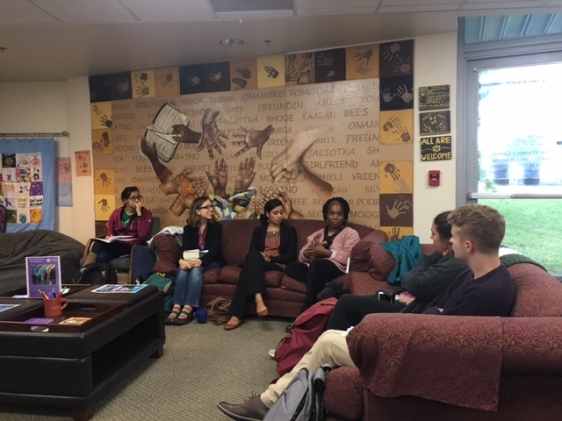Women and the Environment Roundtable Roundup
Last Thursday, October 12th, the Women’s Center held the second roundtable discussion in our fall series. This one was titled Women and the Environment, and prompted a conversation about how women’s work with regard to the environment was different from men’s, as well as how the environment has disparate impacts on women. Ultimately, we set out to answer the daunting question of how we can bring awareness to the intersections of gender, race, and class with regard to environmental justice.

We started off by looking at some of the statistics about women’s employment in environmental fields, which were harder to come by because of its broad and interdisciplinary nature. Still, by looking at large trends (only 12% of the jobs in the green energy industry are held by women), case studies at a few prestigious universities, and patterns of leadership, we found large discrepancies in the rates at which women and men were employed in these sectors.
From there, we moved on to hear what our panelists had to say about larger themes regarding women and the environment. Dr. Dawn Biehler, a professor in the Geography and Environmental Systems department here at UMBC talked about the history of environmental organizations and how many of the white men who ran them blamed women and people of color for environmental degradation and then silenced their voices when it came to conversations about reparations. Dr. Biehler explained ways in which these patterns are seen today, such as the narratives that blame the higher fertility rate of women in the developing world for problems like poverty and hunger, rather than looking at factors like colonization and the unequal distribution of resources.
Sustainability coordinator Tanvi Gadhia talked further about a global perspective and the differences between her work in India with Vandana Shiva and her work in the United States with various sustainability groups. Ultimately, she argued that the hierarchical structures seen in the West benefit those with privilege and hurt marginalized groups like women and people of color. Additionally, she argued that tokenistic inclusion of women and minorities in these groups is not enough; representation does not matter if an institution is not receptive to the voices and leadership of everyone, especially those who have a history of being silenced.
Lastly, graduate student Macey Nortey talked about her work studying disaster relief and the concept of holistic recovery. Because of the bureaucracy associated with receiving aid, it is often difficult for communities to wait for the aid of the federal government. Furthermore, government officials may also be selective about who they deem worthy of receiving aid (see Puerto Rico). Therefore, it is necessary for communities to do some preparation themselves to make up the difference. Holistic recovery is also beneficial in that it allows for everyone’s voice to be heard with equal weight.
Ultimately, the main themes that came out of this conversation were how to be inclusive of marginalized groups and why it’s necessary, understanding how different groups of people have different relationships to the environment and environmental labor, and how access to resources shapes who gets a say in environmental policy. The inclusion of suppressed voices is integral to our social justice ideals–different communities have different needs, and only by including all voices will all needs be met. The disproportionate impacts certain groups of people face in the aftermath of environmental disasters are not coincidental; they are the result of human intervention and it is our responsibility to correct them.
Further Reading:
- Tampons vs. Diva Cups
- The link between feminism and the environment
- Learn about eco-feminism
- An old Women’s Center blog post about why the Flint water crisis is a feminist issue
- Some research from one of our panelists: Dr. Biehler
- Check out a young Baltimore woman who won a prestigious environmental award!
- An interview about women in environmental professions
- Women’s Environment & Development Organization
Posted: October 31, 2017, 1:32 PM